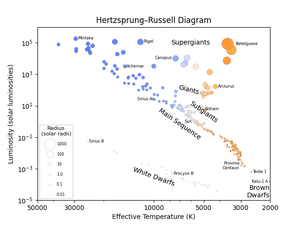Glossarbegriffe: Riesenstern
Description: Riesensterne, kurz Riesen, sind Sterne, die im Vergleich zu anderen Sternen derselben Farbe ungewöhnlich groß und leuchtend sind. Sterne sind nicht von Anfang an Riesen. Stattdessen werden sie in verschiedenen Phasen ihrer Sternentwicklung immer wieder zu Riesensternen.
Bei den meisten Sternen, die keine Riesen sind, besteht ein direkter Zusammenhang zwischen ihrer Farbe und ihrer Leuchtkraft (d. h. der Energie pro Zeit, also ihrer abgestrahlten Leistung). Diese Sterne werden als "Hauptreihensterne" bezeichnet. Sie strahlen Energie ab, da sie in ihrem Kern Wasserstoff zu Helium verbrennen und dadurch Energie freisetzen. Sobald der Wasserstoffvorrat im Kern erschöpft ist, setzt sich die Wasserstofffusion in einer Schale um den Kern herum fort. Der Stern dehnt sich aus und wird viel heller und röter. Schließlich kann die Temperatur im Kern des Sterns so hoch sein, dass die Kernfusion von Elementen, die schwerer als Wasserstoff sind, möglich wird. Das ist eine zusätzliche Energiequelle für den Stern. Im Zuge dessen dehnt sich ein Stern immer weiter aus und seine Oberflächentemperatur sinkt. Dadurch leuchtet er insgesamt viel stärker und wird rötlicher: Der Stern wird zu einem sogenannten Roten Riesenstern, kurz Roter Riese. Auch unsere Sonne wird sich in einigen Milliarden Jahren zu einem Roten Riesen ausdehnen: Dann wird sie hundertmal größer, viel heller und kühler sein als jetzt.
Sterne anderer Massen werden in weiteren, oft kurzlebigen Entwicklungsphasen zu Blauen Riesen oder zu noch leuchtkräftigeren Roten oder Blauen Überriesen.
Riesen gehören zur Leuchtkraftklasse III. Sie sind heller als Unterriesen (Klasse IV), aber lichtschwächer als helle Riesen (Klasse II) und Überriesen (Klasse I).
Insgesamt sind Riesensterne selten. Das liegt daran, dass Sterne eine relativ kurze Zeit ihrer Sternentwicklung als Riese verbringen: Ein Stern wie die Sonne ist rund zehn Milliarden Jahre lang ein Hauptreihenstern, aber nur einige hundert Millionen Jahre lang ein Riesenstern. Aufgrund ihrer hohen Leuchtkraft sind sie jedoch unter den mit bloßem Auge am Nachthimmel sichtbaren Sternen deutlich überrepräsentiert.
Beispiele für Rote Riesen sind Arktur im Sternbild Bärenhüter und Mira im Sternbild Walfisch.
Zugehörige Glossarbegriffe:
See this term in other languages
Term and definition status: The original definition of this term in English have been approved by a research astronomer and a teacher The translation of this term and its definition is still awaiting approval
The OAE Multilingual Glossary is a project of the IAU Office of Astronomy for Education (OAE) in collaboration with the IAU Office of Astronomy Outreach (OAO). The terms and definitions were chosen, written and reviewed by a collective effort from the OAE, the OAE Centers and Nodes, the OAE National Astronomy Education Coordinators (NAECs) and other volunteers. You can find a full list of credits here. All glossary terms and their definitions are released under a Creative Commons CC BY-4.0 license and should be credited to "IAU OAE".
If you notice a factual or translation error in this glossary term or definition then please get in touch.
Related Diagrams
Hertzsprung-Russell diagram
Bildnachweis: IAU OAE/Niall Deacon
License: CC-BY-4.0 Creative Commons Namensnennung 4.0 International (CC BY 4.0) icons









